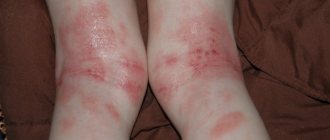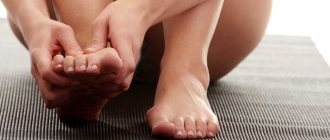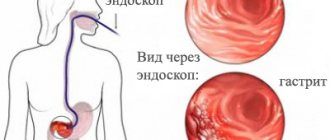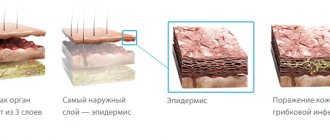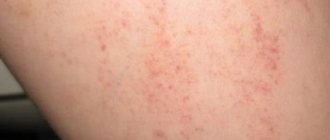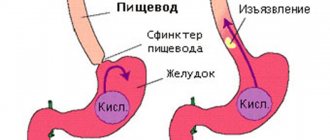The Eustachian tube is a canal in the human middle ear that connects the nasopharynx and the tympanic cavity. Normally he:
- drains mucous membranes, removing exudate and transudate;
- provides air exchange between the cavity and the nasopharynx, expanding when swallowing;
- produces a bactericidal secretion.
If one or all functions are disrupted, eustachitis occurs (other names are tubotympanitis, tubootitis, salpingootitis) - an inflammatory process that affects the mucous membrane of the auditory canal and often develops into otitis media.
Causes
Unilateral or bilateral eustachitis is a consequence of low air exchange in the tympanic cavity caused by certain factors. This:
Complications after:
- ARVI;
- measles, whooping cough, influenza;
- tonsillitis;
- sinusitis.
Structural pathologies, neoplasms:
- overgrowth of adenoids;
- nasopharyngeal polyps;
- irregular shape of the nasal septum;
- enlargement of the posterior ends of the inferior turbinates (hypertrophy).
Medical procedures:
- nasal tamponade in the treatment of bleeding;
- condition after operations on ENT organs.
Sudden changes in pressure:
- in divers, divers during a rapid dive or ascent (mareotite);
- on an airplane during climb and landing (aerootitis).
Allergic reactions with constant inflammation of the mucous membranes (allergic eustacheitis becomes a consequence of vasomotor rhinitis).
Regardless of the cause, the mechanism of occurrence of the disease is the same:
- the tympanic cavity is not sufficiently ventilated;
- the mucous membrane of the Eustachian tube absorbs air;
- pressure in the middle ear decreases;
- transudate (fluid) is formed, inflammation of the auditory tube develops, then otitis media occurs.
How long does it take to treat eustachitis? The process often occurs in an acute form and goes away within a week, but without proper attention it can become chronic. In order to cope with the disease as soon as possible, it is important to contact an otolaryngologist in time for diagnosis and treatment.
Routes of infection
The infection enters the nasopharynx and disrupts its microflora. It damages the mucous layers, passes into the Eustachian tube, and the tympanic cavity. In response to the reaction, the body produces antibodies that cause allergic reactions (swelling). Infections are transmitted by airborne droplets, that is, when talking with an infected person and staying in the same room. The contact route is also possible, that is, using things (for example, dishes, personal hygiene products) of a previously infected person.
In children
The disease usually results from acute respiratory viral infections and upper respiratory tract infections. The younger the child, the more often bilateral eustachitis is diagnosed. Older children suffer from unilateral damage to the auditory tube. Without treatment, painful otitis media can quickly develop. The temperature is normal or slightly elevated, but the child gets tired quickly and eats poorly.
With inflammation of the Eustachian tube, children complain of:
- slight periodic congestion in one or both ears;
- mild pain;
- nausea, dizziness, noise;
- balance disorders;
- the feeling of an “echo” of your own voice in your head, its unusual volume;
- feeling as if water is pouring in the ear or ears.
Infants react to poor health with low-grade fever, tearfulness, refusal to eat, lethargy, poor sleep at night, and regurgitation.
Prevention
For prevention it is necessary:
- strengthen the immune system (hardening, taking vitamin-mineral complexes, eating garlic or keeping it near you);
- protect yourself from foci of infection (vehicles, public places);
- wear a medical mask (change it every couple of hours during the epidemic);
- Treat colds promptly.
These measures will help avoid the occurrence of inflammatory processes in the Eustachian tube.
In adults
Adult patients are characterized by left- or right-sided eustachitis affecting one side without fever, but with a complex of unpleasant symptoms. Patients suffer from:
- congestion in the ears, decreased hearing (low frequencies are almost not perceived);
- autophony (loud distorted perception of one’s own voice in the form of an echo);
- sensation of fluid in the ear;
- headaches or earaches.
Improvement occurs briefly when chewing or after swallowing saliva, food, or when tilting the head due to a short-term opening of the Eustachian tube and a change in fluid level.
Eustachian tube and its role in the hearing aid
The auditory tube connects the tympanic cavity to the nasopharynx. It has the shape of the English letter S and is 3-4 cm in length, with a diameter of no more than a couple of mm. The inside of the canal is covered with mucous epithelium, which helps protect against the penetration of various bacteria. The normal condition is considered to be collapsed walls of the pipe; the passage opens only at the moment of yawning, swallowing and chewing.
The auditory tube performs three important functions in the human body:
- Ventilation – pressure is equalized on both sides of the eardrum. The membrane is a sound-conducting organ; vibration promotes the movement of the auditory ossicles and signal transmission to the inner ear. For good functioning, moderate tension of the eardrum is required, which will ensure its vibration. And this can be achieved with the same atmospheric pressure on the membrane outside and the air pressure in the cavity itself.
- Drainage or transport. The function helps get rid of excess mucus, including fluid during inflammation.
- Protective – provided due to the protective properties of the mucous membrane and lymphoid tissue, which are located under the mucous membrane of the tube. In addition, the air moving through the pipe is cleaned, warmed and moistened.
Infections that enter the tube from the nasopharynx can cause swelling of the mucous membrane, which will lead to a narrowing of the passage and disruption of the natural ventilation function. Even minimal swelling can lead to the cessation of air flow into the middle ear, which causes inflammation of the Eustachian tube, affecting the tube itself and the middle ear.
Diagnostics
Since the symptoms of the disease are sometimes disguised as other ailments, a doctor is needed for an accurate diagnosis. Treatment of eustachitis in adults and children should be carried out exclusively by specialists after the diagnosis has been clarified.
To confirm the disease the following are used:
1. Otoscopy.
The doctor uses an otoscope to examine the outer ear, ear canal, and eardrum. The examination reveals characteristic signs of tubootitis:
- the eardrum is cloudy and retracted;
- the location of structural components is disrupted;
- the auditory canal is narrowed.
2. Audiometry.
Measuring hearing parameters with an electroacoustic audiometer and speech tests. With tubo-otitis, a decrease in perception of up to 20-35 dB is detected.
3. Laboratory examination of discharge (smear).
It is done to determine the causative agents of infection or the allergic nature of the disease.
Classification, types and types of tubootitis
There are two types of disease, depending on the duration of the course - acute tubo-otitis and chronic. In the first case, the condition lasts no more than two weeks, in the second - from a month to a year, rarely longer. Chronic tubo-otitis can develop as a result of multiple relapses if the patient ignored the disease or the treatment was chosen incorrectly.
The danger of chronic eustachitis lies in the high risk of formation of adhesions on the walls of the pipe, which can lead to tissue death. However, this happens extremely rarely if tubo-otitis lasts for years.
In addition, there are several types of the disease:
- right-sided tubo-otitis;
- left-handed;
- bilateral.
Bilateral tubo-otitis means damage to the auditory tube in both ears. The condition is much more severe and dangerous - there is a high risk of developing hearing loss. It is worth noting that in adults this type of tubo-otitis is extremely rare; in most cases it is unilateral.
Acute eustachitis
An acute form of inflammation is a common complication of viruses and infections of the nasopharynx. With insufficient treatment, inflammation continues in the auditory tube. Children often experience pain in both ears; adolescents and adults suffer from unilateral manifestations. When asked how long it takes to treat eustachitis, doctors answer: adequate measures can get rid of it in 5-7 days. If:
- no treatment;
- therapy is insufficient or prescribed incorrectly;
- the course is not completed;
- there are pathologies in the nasopharynx or nasal cavities;
- there is constant allergic inflammation of the mucous membrane
there is a high probability of a prolonged course of tubo-otitis and its chronicity.
Tubootitis: what is it?
The disease has more than 20 other names, including eustachitis, catarrh of the Eustachian tube, serous otitis, salpingootitis and others. Basically, a huge number of names are associated with an attempt to indicate a more precise reason. When the tube becomes “blocked,” middle ear catarrh occurs.
It is worth noting that there is a lot of controversy regarding the appropriateness of the term eustachitis. It means damage to the auditory tube, and tubo-otitis is a disease of the middle ear, which is accompanied by inflammation of the tube. We can conclude that eustachitis together with otitis causes tubootitis. The diseases are related, manifest similar symptoms, and in both cases similar treatment methods are used.
The disease develops gradually:
- The infection enters the auditory tube through the mouth or nose and provokes inflammation of the mucous membrane. Then its swelling occurs and, as a result, the lumen narrows.
- Over time, the infection spreads to the middle ear, causing swelling of its mucous membrane and provoking the release of fluid: serous, purulent, mucus.
- The fluid accumulates and eventually fills the tympanic cavity, then under its pressure the eardrum ruptures and the exudate enters the ear canal.
As a result, ventilation inside the middle ear is impaired, which leads to a drop in pressure, which is important for the conduction of sound impulses. Because of this, the patient’s hearing is impaired and other symptoms of eustachitis appear that characterize the disease.
Children are more susceptible to tubo-otitis than adults, which is associated with incompletely developed organs of smell and hearing.
Complications
Over time, untreated eustacheitis causes:
- acute otitis after ARVI;
- hearing impairment;
- unpleasant sensations of echo, congestion, fluid in the ear;
- problems with coordination;
- headache.
During flights or when diving, patients with chronic eustachitis experience severe discomfort.
It is important to diagnose inflammation of the auditory canals in a child in a timely manner, since without treatment, ARVI will be complicated by catarrhal otitis. Chronic eustachitis and the changes it causes in the middle ear gradually worsen hearing.
Treatment at home
Our ancestors, who did not know the terms eustachitis or tubootitis, noticed that after a long illness, hearing may decrease for a long time and if this condition is not treated, then mild discomfort will be replaced by acute pain or permanent deafness.
Among the recipes of traditional medicine there are ear drops, compresses, and decoctions that are used for drinking or rinsing the nasopharynx. Here are the most effective means:
- Bay leaves are a popular culinary spice that have countercurrent and immune-stimulating effects. Essential oils of the plant can have an antibacterial effect. To prepare ear drops, take 3 medium-sized leaves and pour 100 ml of boiling water over them. Place on the fire and bring to a boil. Leave covered for 2 hours. Inject 2-3 drops, 3 times a day, into each ear.
- Mint is a fragrant plant that has anti-inflammatory and analgesic effects. For eustachitis, use freshly squeezed mint leaf juice or alcohol infusion. A clean cotton wool is rolled into a turunda, moistened with tincture (juice) and inserted into the sore ear for 1-2 hours.
- Plantain is famous for its wound-healing and antibacterial properties. Fresh leaves of the plant are used to treat inflammation of the ear canal. They must be thoroughly washed, crushed using a blender, and then, using gauze, separate the juice. This juice should be injected into both ears, a few drops 3-4 times a day.
- Onion is a powerful phytoncide, a natural antibiotic and anti-inflammatory agent. To treat eustachitis, it is necessary to squeeze out onion juice and dilute it with distilled water in a 1:1 ratio. A cotton swab is soaked in onion juice, wrung out well and inserted into the ear canal for 30-40 minutes.
- Salt is an inexpensive product available to everyone that can relieve swelling during eustachitis and reduce discomfort. Dilute 1 tsp in a glass of warm water. salt and gargle vigorously every few hours until you feel relief. For purulent inflammation, this procedure will help clean the Eustachian tube.
We recommend reading: How to lower the temperature at home - basic methods
Treatment of eustachitis
For the treatment of eustacheitis in adults and children in the acute period, the following can be used:
1. Medicines to destroy infection (antiseptics, antibiotics, anti-inflammatory), relieve swelling (vasoconstrictors, antihistamines).
2. Physiotherapy to shorten the duration of the disease. UV irradiation, sessions on UHF devices, and electrical stimulation are prescribed.
3. Therapeutic manipulations - blowing out the ear (Politzer method), introducing medications directly into the ear canal through a catheter.
To eliminate allergic eustacheitis, or tubootitis, caused by pathology of the ENT organs, you should work with the root causes of the disease - allergies, deviated nasal septum, adenoid growths, etc.
At the multidisciplinary clinic "K+31", treatment of eustachitis in adults and young patients is carried out in the otolaryngology department. Specialists perform diagnostics, develop an action plan, monitor the progress of therapy and strive to prevent relapses of the disease.
Among the advantages of the medical center:
- qualified patient care on an outpatient basis or in a day hospital;
- a full range of necessary laboratory and hardware tests for diagnostics;
- drawing up a treatment regimen using drugs and physiotherapy, innovative techniques;
- if necessary, attracting doctors of other profiles;
- results in the form of recovery or attenuation of the chronic process.
For accurate diagnostics, expert-level equipment is used:
- special installation MODULA EUROPA Paris (Duo) HEINEMANN. It helps make a diagnosis and works as a device for therapeutic manipulations;
- audiometer-impedance meter for analyzing the hearing of young and adult patients.
Thanks to the professionalism of doctors and modern equipment of the department, diagnostics are performed quickly and accurately. After the first visit, the course of treatment begins.
When should you see a doctor?
Whether the treatment is infectious or the treatment of allergic tubo-otitis, you need to start immediately as soon as you notice that your hearing is decreasing and your ears are constantly “stuffed up.” This is quite a dangerous inflammation. Long-term dysfunction of the eustachian tube can lead to adhesions between the auditory ossicles (stapes, malleus and incus), which are involved in sound transmission. This is fraught with permanent hearing loss. The disease can also cause pathologies of the auditory nerve and lead to sensorineural hearing loss. If inflammation leads to the accumulation of purulent masses in the ear, acute purulent otitis media may develop. This diagnosis also has a lot of complications: at a minimum, in the absence of full-fledged therapy, it can develop into chronic otitis in a child and in an adult patient, and at maximum, lead to meningitis, sepsis or complete deafness. Therefore, the disease must be diagnosed as early as possible, as soon as the slightest discomfort appears and does not go away.
How and for how long is tubootitis treated?
In order to cope with the problem of tubo-otitis, treatment must meet several principles:
- Sanitation of the source of infection;
- Reducing swelling;
- Restoring the patency of the auditory tube.
Drug treatment
Help for diseases of the auditory tube should be comprehensive; this is the only way to quickly cope with the problem. In order to eliminate the infection, antibacterial drugs are used. Most often these are penicillin antibiotics, sometimes fluoroquinolones. Drugs from the xylometazoline group are used as a vasoconstrictor; in the case of allergic rhinitis, steroid drugs are used.
To restore the patency of the auditory tube, all discharge from the ear is removed, and turundas with antiseptic solutions are used.
Many people wonder how long tubo-otitis will last? It all depends on what stage of the disease treatment is started. The later, the longer the recovery period will be. Physiotherapy methods will be a good assistant in this difficult task. Although we would like to get rid of the disease as soon as possible, this is not always possible and we need to tune in to fight inflammation.
Physiotherapeutic treatment
Stages of applying a compress.
- Warming up. Use regular dry heat. This can be warming semi-alcohol compresses or instillation of boric alcohol into the ear. After this, the ear is tied with a warm scarf. Such measures cannot be used if the disease is purulent.
- Blowing. Most often used for long-term congestion in the ear after the intensity of the inflammatory process has subsided.
- Physio-procedures. UHF therapy is used as a remedy against microorganisms, pneumomassage is used to improve the outflow of exudate from the middle ear.
Typically, acute tubo-otitis can be dealt with within a period of three to seven days. If it becomes chronic, treatment takes months and even years.
Attention! Do not resort to folk remedies without consulting a specialist in otorhinolaryngology. You may not only not improve the situation, but also worsen the course of the disease!
Folk remedies
To restore the patency of the pipe, you can use traditional medicine. These are decoctions or drops to cleanse the nasopharynx of mucus, infusions for oral administration to strengthen the immune system, steam baths or inhalations.
Popular methods:
- Warm up a piece of onion, wrap it in a bandage, and put it in your ear as deep as possible. Leave it overnight and drop a few drops of onion juice into your nose. The course of treatment lasts a month.
- Two tablespoons of herbal mixture, consisting of equal proportions of lavender, eucalyptus, yarrow, dandelion and celandine, pour 500 ml of boiling water, leave in a thermos overnight. Take a quarter glass a day or soak turunda in the infusion and insert it into the ear canal for half an hour.
- Mix the crushed head of garlic, pour in 120 ml of sunflower oil, and blend in a blender for 20 seconds. Leave the mixture for 11 days, shake occasionally. Strain and add a couple of drops of glycerin. Use the warm mixture for instillation into the ear once a day at night for a monthly course.
- Boil a couple of potatoes without salt, cover the pan with hot water with a towel, and inhale the steam for 10-15 minutes. Repeat daily until your health returns to normal.
- Rinse the nose with aloe juice. Squeeze the juice from several young leaves of the plant, mix with the same amount of warm water, rinse your nose, alternately sucking the liquid from the saucer of each nostril and carefully blowing your nose. The solution can be used to instill 10 ml into the ears, divided into 4 procedures, or to moisten cotton wool and place them in the ear canal.
Classification
The disease is classified according to several criteria.
Flow form:
- Acute tubo-otitis. Active inflammation that develops when the infection moves from the nose or throat. Acute tubo-otitis is manifested by severe swelling of the auditory tube and severe symptoms. Timely treatment ensures a quick recovery.
- Chronic turbootitis is a protracted form of the disease, when the symptoms are mild, but atrophic and sclerotic processes in the eustachian tube are noted. The danger of this form of the disease is that it affects the eardrum and cavity. As a rule, in the chronic form, the membrane becomes distorted and becomes cloudy.
Origin of the disease:
- Infectious eustachitis. The disease is associated with the transfer of infection from the throat or nose.
- Consequence of barotrauma. The disease occurs due to injuries from excessive pressure. This category includes mareotite (a consequence of pressure changes when diving to depth or ascent) and aerootite (a consequence of pressure changes during air travel).
- Allergic eustachitis. A consequence of allergic reactions that cause inflammation of the mucous membrane.
Localization of the disease:
- Unilateral eustachitis is a lesion on one side.
- Bilateral eustachitis - if the lesion occurs on both sides, bilateral turbootitis is diagnosed.


